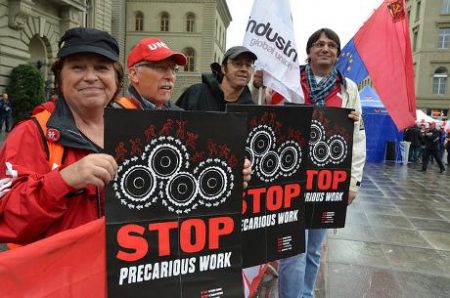August 7, 2016 – The word that describes these people is precariat and they have been referred to as “the dangerous class” by British economist Guy Standing, from the London School of Economics, in his a recent book on the subject.
Why dangerous?
Because they are supplicants to those in power. They have to beg and plead to get relief such as extending unemployment benefits years after their jobs have vanished. They feel insecure and insecurity leads to anger. They feel like they are the outsiders and are drawn to demagoguery.
The precariat are the new underclass often referred to as the 99ers, meaning they are of the super rich 1%. In the United States the precariat are mostly the people of the deindustrialized American heartland, predominantly white and working class, but also African American and Hispanic. A minority have post-secondary education but the vast majority don’t. For those in the former group their educational credentials have not led to permanent jobs like the ones for life that their high school or less educated male parents were able to secure in the past.
What else characterizes the precariat?
They are people who haven’t been passed by because of anything they have or have not done. What has changed is the world around them. It has sped up driving past them at an ever increasing pace bringing economic and technological disruption.
They are not Luddites. They happily would work on an assembly line building products if it meant a good paycheck, steady work, benefits and a comfortable retirement. Their ancestors came to America drawn by a dream of liberty and economic opportunity. The America they idealize was the builder of products sold to the world. The America they have read about helped win two world wars. Their America still has dreams of the old western frontier. But there is no new real estate to claim. Yet that is the America that Donald Trump keeps promising them in the run up to this year’s presidential election. And that America no longer exists and nor can it be brought back. Instead the new precarait world is driven by dizzying change and innovation, a world of invention and disruption coming not once a decade or two, but once a month or even once a week. It’s a world facing global warming, a world transitioning to a low-carbon future with all its unknowns. It’s a scary world to those not riding the wave of change. Instead they are drowning, being towed under by precarious work, low incomes and lower expectations. Upward mobility is gone. It’s all down from here.
In his book Standing describes the impact on the precariat of a changing world. The changes of the last quarter century have laid the seeds. These include:
- the rise of global trade
- offshore outsourcing of jobs
- the Internet
- automation and robotics
- artificial intelligence
The social engineering effect has produced the following:
- unstable or inconstant work and no job security.
- for the underemployed few social guarantees such as unemployment benefits or social insurance.
- a disproportionate impact on women, migrants, minorities and youth.
In an article written by the columnist David Brooks, appearing in The New York Times in 2014, he describes the growing population of have-nots that have doubled since 1988. The points out his prime evidence, a lack of mobility and writes, “In 1950, 20 percent of Americans moved in a given year. Now, it’s around 12 percent. In the 1950s and 1960s, people lived in the same house for an average of five years; now people live in the same house for an average of 8.6 years. When it comes to geographic mobility, we are now at historic lows…” He equates these phenomena with two factors:
- an aging population
- young people’s opportunities
He continues, “Between the 1980s and the 2000s alone, mobility among young adults dropped by 41 percent.” A factor for less mobility, he states, is the lack of diverse job types in the United States today. A job in Pittsburgh today isn’t too dissimilar from a job in Atlanta he states and deindustrialization is the single greatest contributor. The mobility he uses as evidence has also change. In the past it was a sign of getting ahead. But not today. When people move for the most part now they are seek cheaper housing which usually means they are moving into areas with less job opportunity and economic activity.
Despite my best efforts I couldn’t find a labour statistic or census data that pinpointed the number of precariat in the United States today. One can imagine the number is in the tens of millions but as of yet it hasn’t become a firm statistical measure and it should. Because once the extent of the problem is known in mathematical terms then policy can be developed with budgets to attempt to address it.
In a recent article in The Globe and Mail, the size of the precariat is estimated to be as much as 40% of the adult population. But again, no one north of the 49th parallel is measuring it as of yet. And they should.
Not Addressing the Challenge Has Consequences
What has not addressing the crisis of the precariat done so far?
Some pundits point to the Brexit vote as precariat dissent expressing itself. Others think the popularity of Donald Trump is a direct consequence of the rising precariat in the United States. Others point to the Occupy Wall Street social movement as more evidence of precariat opposition to the status quo.
So what are the answers?
Hillary Clinton talks about replacing lost coal mining jobs through retraining miners to get them into the clean energy jobs of the future. That may not be easy for people who have been locked into one kind of work for so long they no longer can easily be trained to do something new.
The current Canadian federal government under Justin Trudeau is weighing a options including increased tax credits, family supplementary income and even establishing a national minimum income for all adult citizens similar to the current experiment being tried in Finland.
Labour organizers see unions as the answer to give the precariat collective bargaining leverage.
And others see the rise of a precariat party to create change through the ballot box.









